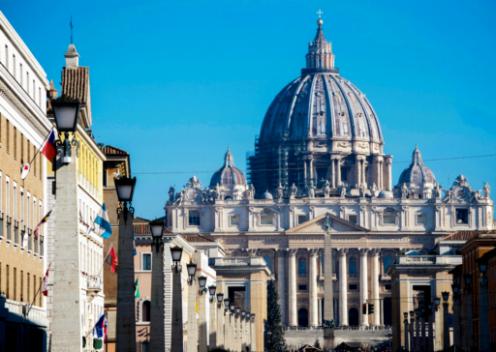St. Peter's Throne, also known as Cathedra Petri, is a significant architectural and religious symbol within the Vatican City. The Cathedra Petri holds a prominent role in papal tradition and has been depicted artistically throughout history.

Architectural Features of the Cathedra Petri
The Cathedra Petri, also known as St. Peter's Throne, is located within St. Peter's Basilica in Vatican City. This stunning architectural piece is a monumental chair made of bronze and designed by Gian Lorenzo Bernini. The chair is elevated on a platform and surrounded by a massive gilded frame, creating a grand and majestic presence within the basilica. The intricately carved details and elaborate decorations on the chair showcase the skill and craftsmanship of the artisans involved in its creation. The chair is flanked by four colossal statues representing the Doctors of the Church, adding to the grandeur and significance of the Cathedra Petri. The architectural features of the Cathedra Petri highlight its importance as a symbol of the authority and leadership of the papacy within the Catholic Church.
Religious Symbolism within the Cathedra Petri
The Cathedra Petri, or St. Peter's Throne, holds significant religious symbolism within the Catholic tradition. As the traditional seat of the Pope, the Cathedra Petri represents the authority and leadership of the papacy. The inclusion of a symbolic chair in the design of the cathedral serves as a physical representation of the role of the Pope as the successor of St. Peter, the first Pope according to Catholic belief. The Cathedra Petri is a powerful symbol of the continuity of the papacy and the unbroken line of succession from St. Peter to the present day. Additionally, the presence of the Cathedra Petri within St. Peter's Basilica emphasizes the importance of the Pope as the spiritual leader of the Catholic Church and the representative of Christ on earth. The intricate design and decoration of the Cathedra Petri also contain religious symbolism, with elements such as angels, cherubs, and intricate carvings that reflect the divine nature of the papacy and its connection to heavenly powers. The Cathedra Petri serves as a visual reminder of the spiritual authority and divine guidance that guides the actions and decisions of the Pope, reinforcing the sacred and holy nature of the Catholic Church and its leadership.
Role of the Cathedra Petri in Papal Tradition
The Cathedra Petri, or St. Peter's Throne, plays a significant role in Papal tradition. As the symbol of the Bishop of Rome's authority and leadership within the Catholic Church, the Cathedra Petri is a physical representation of the Pope's role as the successor to St. Peter. The Chair of St. Peter, housed within the Cathedra Petri, serves as a reminder of the Pope's role as the spiritual leader of the Church and the protector of the faith. Throughout history, the Cathedra Petri has been a focal point of papal ceremonies and important events, such as the Pope's inauguration and the celebration of feast days. The Cathedra Petri also serves as a symbol of unity within the Church, representing the Pope's role as the bridge between God and the faithful. In Papal tradition, the Cathedra Petri is not just a physical object, but a sacred symbol of the Pope's authority and spiritual guidance for the Catholic faithful.
Artistic Depictions of the Cathedra Petri
Artists have used various mediums to capture the significance and grandeur of this sacred throne.
One of the most famous artistic depictions of the Cathedra Petri is found in Gian Lorenzo Bernini's masterpiece, the Cathedra Petri Altarpiece, located in St. Peter's Basilica. This stunning piece features a monumental chair, supported by four colossal figures representing the four Fathers of the Church. The intricate details and lifelike sculptures in this work serve to emphasize the importance of the Cathedra Petri in the Catholic tradition.
Another notable artistic representation of the Cathedra Petri can be seen in the frescoes of the Vatican's Apostolic Palace. Paintings by renowned artists such as Raphael and Michelangelo showcase the Cathedra Petri as a symbol of papal authority and spiritual leadership. These intricate murals bring to life the religious symbolism and historical significance of the Cathedra Petri.
In addition to paintings and sculptures, the Cathedra Petri has also been depicted in various forms of decorative art, such as stained glass windows, tapestries, and mosaics. These artistic renderings offer different interpretations of the Cathedra Petri, each highlighting its role as a sacred symbol of the papacy.
Overall, the artistic depictions of the Cathedra Petri serve to convey the profound spiritual and cultural significance of this ancient throne. Through various mediums and styles, artists have captured the essence of the Cathedra Petri, celebrating its role in papal tradition and religious symbolism.
